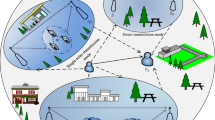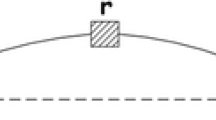Abstract
Optimal relay selection in large-scale networks is a difficult task since the network is usually considered as blind due to the high volume and collection difficulty of the relays’ information. In this paper, we develop a collision resolving relay selection (CReS) scheme that achieves the optimal relay from a random set of candidates without the previous knowledge of any individual relay. By introducing stochastic geometry based quality-of-service region, the relation between the distribution of the available relay number and the transmission request is established. Furthermore, the selection phase of the CReS scheme is divided into two sub-phases according to different distributions of the relay number in boundless and bounded regions. A switch rule is proposed when several relays collide in the first sub-phase, followed by the second sub-phase to resolve the collision with the splitting algorithm. The optimal solution that requires minimum selection slots for all sub-phases is derived. In addition, a sub-optimal solution is also explored to reduce the computational complexity. The scheme shows a better applicability than conventional information-based schemes in view of its little information requirement when dealing with large-scale relay allocation problems.















Similar content being viewed by others
Notes
Only single relay selection is considered in this paper.
It is clear that with no blank region, the available region and the QoS region are equal in the first unit.
Relays in the original relay region \({\mathbb {R}}^2\) is no longer a PPP in the second unit since a determined blank region \({\mathcal {S}}^{\mathrm{B}}\) has already been observed.
References
Song, H. H., Qiu, L., & Zhang, Y. (2009). NetQuest: A flexible framework for large-scale network measurement. IEEE/ACM Transactions on Networking, 17(1), 106–119.
Kim, S., & Chun, Y. (2013). Reliability-rate tradeoff in large-scale multiple access relay networks. IEEE Journal on Selected Areas in Communications, 31(8), 1414–1422.
Koulali, M.-A., Rabat, M., Kobbane, A., El Koutbi, M., & Ben-Othman, J. (2012). Optimal distributed relay selection for duty-cycling wireless sensor networks. In: Proceedings of GLOBECOM (pp. 145–150).
Zou, Y., Wang, X., & Shen, W. (2013). Intercept probability analysis of cooperative wireless networks with best relay selection in the presence of eavesdropping attack. In Proceedings of ICC (pp. 2183–2187).
Chen, G., Tian, Z., Gong, Y., & Chambers, J. (2014). Decode-and-forward buffer-aided relay selection in cognitive relay networks. IEEE Transactions on Vehicular Technology, 63(9), 4723–4728.
Seyfi, M., Muhaidat, S., Liang, J., & Dianati, M. (2011). Effect of feedback delay on the performance of cooperative networks with relay selection. IEEE Transactions on Wireless Communications, 10(12), 4161–4171.
Yan, Y., Huang, J., & Wang, J. (2013). Dynamic bargaining for relay-based cooperative spectrum sharing. IEEE Journal on Selected Areas in Communications, 31(8), 1480–1493.
Chae, C., Tang, T., Heath, R. W, Jr., & Cho, S. (2008). MIMO relaying with linear processing for multiuser transmission in fixed relay networks. IEEE Transactions on Signal Processing, 56(2), 727–738.
Jing, Y., & Jafarkhani, H. (2009). Single and multiple relay selection schemes and their achievable diversity orders. IEEE Transactions on Wireless Communications, 8(3), 1414–1423.
Zou, Y., Champagne, B., Zhu, W., & Hanzo, L. (2015). Relay-selection improves the security-reliability trade-off in cognitive radio systems. IEEE Transactions on Communications, 63(1), 215–228.
Ouyang, F., Ge, J., & Hou, J. (2014). Cooperative waiting-time reduction for cognitive radio networks using Stackelberg game. IET Communications, 8(17), 3072–3080.
Park, S., Kim, D., & Nam, S. (2011). Adaptive threshold based relay selection for minimum feedback and channel usage. IEEE Transactions on Wireless Communications, 10(11), 3620–3625.
Tao, T., & Czylwik, A. (2013). Beamforming design and relay selection form multiple MIMO AF relay systems with limited feedback. In Proceedings of IEEE VTC Spring (pp. 1–5).
Zhang, X., Jafarkhani, H., Ghrayeb, A., & Hasna, M. O. (2014). Relay assignment in multiple source-destination cooperative networks with limited feedback. IEEE Transactions on Wireless Communications, 13(10), 5741–5751.
Taleb, T., & Ksentini, A. (2013). Follow me cloud: Interworking federated clouds and distributed mobile networks. IEEE Networks, 27(5), 12–19.
Ouyang, F., Ge, J., Gong, F., & Hou, J. (2015). Random access based blind relay selection in large-scale relay networks. IEEE Communications Letters, 19(2), 255–258.
Qin, X., & Berry, R. (2004). Opportunistic splitting algorithms for wireless networks. In Proceedings of INFOCOM (pp. 1662–1672).
Shah, V., Mehta, N. B., & Yim, R. (2010). Splitting algorithms for fast relay selection: Generalizations, analysis, and a unified view. IEEE Transactions on Wireless Communications, 9(4), 1525–1535.
Shah, V., Mehta, N. B., & Yim, R. (2010). The relay selection and transmission trade-off in cooperative communication systems. IEEE Transactions on Wireless Communications, 9(8), 2505–2515.
Baccelli, F., & Blaszczyszyn, B. (2009). Stochastic geometry and wireless networks: Volume I–Theory. Foundations and Trends in Networking, 3(3/4), 249–449.
Cho, S., Choi, W., & Huang, K. (2011). QoS provisioning relay selection in random relay networks. IEEE Transactions on Vehicular Technology, 60(6), 2680–2689.
Li, B., Li, H., Wang, W., Hu, Z., & Yin, Q. (2013). Energy-effective relay selection by utilizing spacial diversity for random wireless sensor networks. IEEE Communications Letters, 17(10), 1972–1975.
Zhai, C., Zhang, W., & Mao, G. (2012). Cooperative spectrum sharing between cellular and Ad-Hoc networks. IEEE Transactions on Wireless Communications, 13(7), 4025–4037.
Lin, Z., Li, Y., Wen, S., Gao, Y., Zhang, X., & Yang, D. (2014). Stochastic geometry analysis of achievable transmission capacity for relay-assisted device-to-device networks. In Proceedings of ICC (pp. 2251–2256).
Deng, N., Zhang, S., Zhou, W., & Zhu, J. (2012). A stochastic geometry approach to energy efficiency in relay-assisted cellular networks. In Proceedings of GLOBECOM (pp. 3484–3489).
Laneman, J. N., Tse, D. N. C., & Wornell, G. W. (2004). Cooperative diversity in wireless networks: Efficient protocols and outage behavior. IEEE Transactions on Information Theory, 50(12), 3062–3080.
Baddeley, A. (2007). Spatial point processes and their applications. In Stochastic Geometry, Lecture Notes in Mathematics (pp. 1–75). Springer.
Acknowledgments
The work was supported by the National Hightech R&D Program of China (2014AA01A704), the National Basic Research Program of China (2012CB316100), the National Natural Science Foundation of China (61372067), the Science and Technology Research and Development Program of Shaanxi Province (2014KJXX-49), the 111 Project (B08038), and the National Natural Science Foundation of China (61501058). The authors would like to thank the anonymous reviewers for their valuable comments and suggestions.
Author information
Authors and Affiliations
Corresponding author
Appendices
Appendix 1: Derivation of formula (10)
When \(n=1\), the resolution success probability \(P^\mathbf{S2}(p_{_{{\mathbf{V}}_0}})\) is the probability that only 1 relay is available among \(k_0\) colliding relays. Considering the relay number distribution of \(K(|{\mathcal {S}}^{\mathrm{C}}_{{\mathbf{V}}_0}|)=k_0\) (\(2 \le k_0 < \infty\)) in (1), the expressions of \(P^\mathbf{S2}(p_{_{{\mathbf{V}}_0}})\) and \({{\mathbf{V}}_0}\) are given by
When \(n=2\), the formula of \(P^\mathbf{S2}(p_{_{{\mathbf{V}}_1}})\) depends on the resolution result in \(n=1\). There are two possible results when \(n=1\) fails: idle (0) or collision (1). If idle, all \(k_0\) colliding relays in the first unit still collide in the second unit, resulting formula (21). Otherwise in a probability of \(P_{k_1}^{k_0}(p_\phi ), k_1\) out of \(k_0\) relays (\(2 \le k_1 \le k_0\)) collide and the expression is given in (22).
When \(n=3\), similar to \(n=2\), there are also two failure results for each situation in \(n=2\), forming 4 results in all. The expression of \(P^\mathbf{S2}(p_{_{{\mathbf{V}}_2}})\) when \({\mathbf{V}}_2=[0,0], [0,1], [1,0]\), and [1, 1] are given below, respectively.
Based on the formulas for \(n=1,2,3\ldots\), we can conclude that there are \(2^{n-1}\) forms of expression for \(P^\mathbf{S2}(p_{_{{\mathbf{V}}_{n-1}}})\), which is directed by \({\mathbf{V}}_{n-1}\). A general expression for \(P^\mathbf{S2}(p_{_{{\mathbf{V}}_{n-1}}})\) is therefore summarized in (10). Since the number of 1 in \({\mathbf{V}}_{n-1}\) expresses the collision time in S2 and only when a collision happens will the number of colliding relays changes, \(M_{i-1}[{\mathbf{V}}_{n-1}]\) is therefore denoted as the collision time indicator and the subscripts for k. Also, due to the fact that the history vector of any previous unit is fixed when \({\mathbf{V}}_{n-1}\) for the nth unit is given, we denote \(\mathbf{L}_{i-1}[{\mathbf{V}}_{n-1}]\) as the previous history vector and the subscript of p for the ith unit.
Appendix 2: Derivation of formulas (11) and (12)
When \(n=1, {\mathbf{V}}_0=\phi\), the collision region \({\mathcal {S}}_\phi ^{\mathrm{C}}\) and blank region \({\mathcal {S}}_\phi ^{\mathrm{B}}\) are equal to the available region \({\mathcal {S}}_m ^{\mathrm{AR}}\) and blank region \({\mathcal {S}}_m ^{\mathrm{B}}\) in the last unit of S1, respectively. The expressions of \(|{\mathcal {S}}_{\phi }^{\mathrm{AR}}|\) and \(|{\mathcal {S}}_{\phi }^{\mathrm{B}}|\) are given as
When \(n=2\), if \({\mathbf{V}}_1=[0]\), there is no available relay in \({\mathcal {S}}_\phi ^{\mathrm{AR}}\) and it is added to blank region \({\mathcal {S}}_\phi ^{\mathrm{B}}\). \({\mathcal {S}}_{[0]}^{\mathrm{C}}\) is therefore the complementary region of \({\mathcal {S}}_\phi ^{\mathrm{AR}}\) in \({\mathcal {S}}_\phi ^{\mathrm{C}}\). The expressions of \(|{\mathcal {S}}_{[0]}^{\mathrm{AR}}|\) and \(|{\mathcal {S}}_{[0]}^{\mathrm{B}}|\) are given as
If \({\mathbf{V}}_1=[1]\), more than one available relay exists in \({\mathcal {S}}_\phi ^{\mathrm{AR}}\), making it the new collision region \({\mathcal {S}}_{[1]}^{\mathrm{C}}\). Thus \({\mathcal {S}}_{[1]}^{\mathrm{B}}\) remains unchanged. The expressions of \(|{\mathcal {S}}_{[1]}^{\mathrm{AR}}|\) and \(|{\mathcal {S}}_{[1]}^{\mathrm{B}}|\) are given as
When \(n=3\), the discussion is similar to \(n=2\). The expressions for \(|{\mathcal {S}}_{{\mathbf{V}}_2}^{\mathrm{AR}}|\) and \(|{\mathcal {S}}_{{\mathbf{V}}_2}^{\mathrm{B}}|\) when \({\mathbf{V}}_2=[0,0], [0,1], [1,0]\), and [1, 1] are given below, respectively.
According to Algorithm 2, \(|{\mathcal {S}}^{\mathrm{AR}}_{{\mathbf{V}}_{n-1}}|\) is influenced by all elements in \({\mathbf{V}}_{n-1}\). As ()–() shows, if collision occurs, \(p_{_{{\mathbf{L}_{i-1}}[{{\mathbf{V}}_{n-1}}]}}\) will be multiplied to \(|{\mathcal {S}}_{{\mathbf{L}_{i-1}}[{{\mathbf{V}}_{n-1}}]}^{\mathrm{C}}|\). Otherwise if idle occurs, \((1-p_{{_{{\mathbf{L}_{i-1}}[{{\mathbf{V}}_{n-1}}]}}})\) will be multiplied to \(|{\mathcal {S}}_{{\mathbf{L}_{i-1}}[{{\mathbf{V}}_{n-1}}]}^{\mathrm{C}}|\). Given the history vector \({\mathbf{V}}_{n-1}\) and the corresponding set of \(p_{{_{{\mathbf{L}_{i-1}}[{{\mathbf{V}}_{n-1}}]}}}\), the generalized expression of \(|{\mathcal {S}}_{{\mathbf{V}}_{n-1}}^{\mathrm{AR}}|\) can be concluded as (11). Similarly, \(|{\mathcal {S}}_{{{\mathbf{V}}_{n-1}}}^\mathrm{B}|\) increases only when idle occurs, its expression is concluded as
The final area of the QoS region \(|{\mathcal {S}}_{{{\mathbf{V}}_{n-1}}}|\) is the summation of \(|{\mathcal {S}}_{{{\mathbf{V}}_{n-1}}}^{\mathrm{AR}}|\) and \(|{\mathcal {S}}_{{{\mathbf{V}}_{n-1}}}^{\mathrm{B}}|\), and is obtained by (12).
Rights and permissions
About this article
Cite this article
Ouyang, F., Ge, J., Gong, F. et al. Collision resolving relay selection in large-scale blind relay networks. Wireless Netw 23, 1793–1807 (2017). https://doi.org/10.1007/s11276-016-1254-7
Published:
Issue Date:
DOI: https://doi.org/10.1007/s11276-016-1254-7




